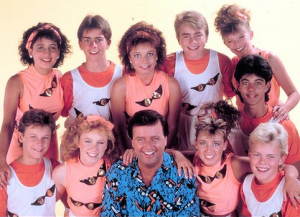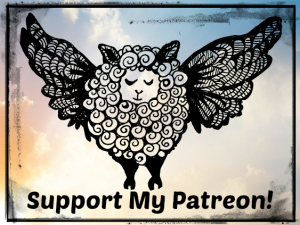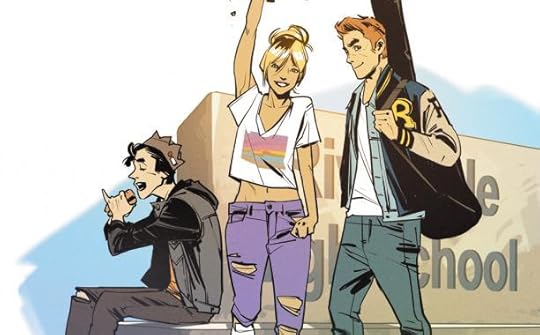Tansy Rayner Roberts's Blog, page 31
February 28, 2016
Galactic Suburbia 137 Show Notes
Young Talent Time!
In which we welcome a new member of the Galactic Suburbia: Next Gen, and embrace the awards season.
Baby News: Happy birth to future feminist awesome little dude Samuel, and congrats to his parents, Alisa & Chris as well as newly minted big sister Mack!
Mark Oshiro, ConQuest & the whiteness of cons/fan spaces
Mark Does Stuff Etc.
Mark’s original post
Mark’s follow up
Stephanie Lai at No Award on Taking Up Room in Con Spaces
(also Ben and Han Solo at home)
CULTURE CONSUMED
Alex: Finished Molly. Triton, Samuel Delany; Wicked + Divine; Illuminae, Amie Kaufman and Jay Kristoff.
Tansy: Molly also :D, Gentleman Jole & the Red Queen by Lois McMaster Bujold, Marvel Avengers Academy, Gilmore Girls, Buffy Rewatch with Daughter!!!
Skype number: 03 90164171 (within Australia) +613 90164171 (from overseas)
Please send feedback to us at galacticsuburbia@gmail.com, follow us on Twitter at @galacticsuburbs, check out Galactic Suburbia Podcast on Facebook, support us at Patreon and don’t forget to leave a review on iTunes if you love us!
Sheep Might Fly: Fake Geek Girl Part 6 Show Notes
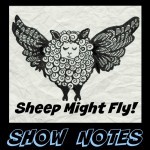 New episode of Sheep Might Fly!
New episode of Sheep Might Fly!
You can listen now to Episode 6 on iTunes (or your own favourite podcast app, I hope), and also stream, download & follow Sheep Might Fly here on the Podbean site.
“Fake Geek Girl,” was originally published in Review of Australian Fiction Volume 14, Issue 4. You can buy the issue containing the story (along with a fantastic piece from Stephanie Lai) directly from their website.
Meet Fake Geek Girl, the band that plays nerdy songs at the university bar every Friday night, to a mixture of magical and non-magical students: lead singer Holly writes songs based on her twin sister Hebe’s love of geek culture though she doesn’t really understand it; drummer Sage is an explosive sorcerous genius obsessing over whether Holly’s about to quit the band to go mainstream; shy Juniper only just worked up the nerve to sing her own song in public and keeps a Jane Austen themed diary chronicling the lives and loves of her friends. When the mysterious, privileged Ferd joins their share house, everything starts to unravel…
In Part 6, Texts From Monday (in a super short update), Sage ditches band practice and Holly gives him a piece of her mind.
Missed previous episodes? Start from the beginning with Episode 1, Episode 2 or Episode 3, Episode 4, Episode 5.
If you like what you hear on Sheep Might Fly, check out Tansy’s blog at tansyrr.com. Talk to Tansy on Twitter (@tansyrr), or check out her other podcasts: Galactic Suburbia and Verity!
You can become a supporter of Tansy & the Sheep Might Fly podcast at Patreon.
February 23, 2016
Sheep Might Fly: Fake Geek Girl Part 5 Show Notes
 New episode of Sheep Might Fly!
New episode of Sheep Might Fly!
You can listen now to Episode 5 on iTunes (or your own favourite podcast app, I hope), and also stream, download & follow Sheep Might Fly here on the Podbean site.
Thank you so much to everyone who nominated “Fake Geek Girl” for a Ditmar, and congratulations to all the nominees.
“Fake Geek Girl,” was originally published in Review of Australian Fiction Volume 14, Issue 4. You can buy the issue containing the story (along with a fantastic piece from Stephanie Lai) directly from their website.
Meet Fake Geek Girl, the band that plays nerdy songs at the university bar every Friday night, to a mixture of magical and non-magical students: lead singer Holly writes songs based on her twin sister Hebe’s love of geek culture though she doesn’t really understand it; drummer Sage is an explosive sorcerous genius obsessing over whether Holly’s about to quit the band to go mainstream; shy Juniper only just worked up the nerve to sing her own song in public and keeps a Jane Austen themed diary chronicling the lives and loves of her friends. When the mysterious, privileged Ferd joins their share house, everything starts to unravel…
In Part 5, Hebe and the Magical Fire Alarm Meet-Cute, we learn the specific problems that come with fire safety in magical share houses, and Hebe finally starts to figure out what Ferd’s deal is anyway.
Missed previous episodes? Start from the beginning with Episode 1, Episode 2 or Episode 3, Episode 4.
If you like what you hear on Sheep Might Fly, check out Tansy’s blog at tansyrr.com. Talk to Tansy on Twitter (@tansyrr), or check out her other podcasts: Galactic Suburbia and Verity!
You can become a supporter of Tansy & the Sheep Might Fly podcast at Patreon.
February 14, 2016
Sheep Might Fly: Fake Geek Girl Part 4 Show Notes
 New episode of Sheep Might Fly!
New episode of Sheep Might Fly!
You can listen now on iTunes (or your own favourite podcast app, I hope), and also stream, download & follow Sheep Might Fly here on the Podbean site.
Thank you so much to everyone who nominated “Fake Geek Girl” for a Ditmar, and congratulations to all the nominees.
“Fake Geek Girl,” was originally published in Review of Australian Fiction Volume 14, Issue 4. You can buy the issue containing the story (along with a fantastic piece from Stephanie Lai) directly from their website.
Meet Fake Geek Girl, the band that plays nerdy songs at the university bar every Friday night, to a mixture of magical and non-magical students: lead singer Holly writes songs based on her twin sister Hebe’s love of geek culture though she doesn’t really understand it; drummer Sage is an explosive sorcerous genius obsessing over whether Holly’s about to quit the band to go mainstream; shy Juniper only just worked up the nerve to sing her own song in public and keeps a Jane Austen themed diary chronicling the lives and loves of her friends. When the mysterious, privileged Ferd joins their share house, everything starts to unravel…
Part 4 is an excerpt from the Elegant and Articulate Diary of Miss Juniper Cresswell, Gentlewitch and Scholar, in which the lady muses on the hardships of her life, chronicles a certain disastrous share house dinner party, ignores her ongoing crush on Holly Hallow and her pretty hair, and embraces a brand new One True Pairing.
Missed previous episodes? Start from the beginning with Episode 1, Episode 2 or Episode 3.
If you like what you hear on Sheep Might Fly, check out Tansy’s blog at tansyrr.com. Talk to Tansy on Twitter (@tansyrr), or check out her other podcasts: Galactic Suburbia and Verity!
You can become a supporter of Tansy & the Sheep Might Fly podcast at Patreon.
Galactic Suburbia Episode 136
New episode is up! Get it here!
(Oh and since we recorded this up, Galactic Suburbia and Letters to Tiptree both received Ditmar nominations, thanks to our Australian listeners/readers who nominated us!)
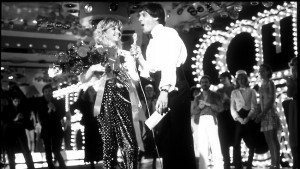 In which Alex and Tansy leap back into 2016 to talk Awards (it’s that season again!), comics, novellas, mysterious London novels and epic feminist canon. Also, Molly Meldrum.
In which Alex and Tansy leap back into 2016 to talk Awards (it’s that season again!), comics, novellas, mysterious London novels and epic feminist canon. Also, Molly Meldrum.
Locus Recommended Reading List.
BSFA Awards shortlist
Letters to Tiptree 99 cents! Bestseller on Amazon!
Tansy’s new podcast plug! Sheep Might Fly & Fake Geek Girl
Kickstarter for Ursula Le Guin documentary.
Nominating for Hugos (til end of March) don’t forget.
And Part 1 of the University of Oregon’s Tiptree Symposium, with Julie Phillips – (Alex says: sorry not sorry, Tansy)
CULTURE CONSUMED:
Tansy: Hellcat by Kate Leth & Brittney Williams, Archie by Mark Waid & Fiona Staples, The Honey Month by Amal El-Mohtar, The Beatriceid by Kate Elliott, “Binti” by Nnedi Okorafor, “The Heart is Eaten Last” by Kameron Hurley (note: Kameron says any new Patreon subscriber automatically gets access to all the stories she has posted so far including this one – bargain at as little as $1 a month!)
Alex: Jonathan Strange and Mr Norrell, Susannah Clarke; Neverwhere, Neil Gaiman (plus others of course). The Just City, Jo Walton; Walk to the End of the World, Suzy McKee Charnas. MOLLY.
Skype number: 03 90164171 (within Australia) +613 90164171 (from overseas)
Please send feedback to us at galacticsuburbia@gmail.com, follow us on Twitter at @galacticsuburbs, check out Galactic Suburbia Podcast on Facebook, support us at Patreon and don’t forget to leave a review on iTunes if you love us!
Mary Vindicated: The Life & Politics of Mary Wollstonecraft
Great Ladies of History is a Patreon-sponsored essay series for tansyrr.com! One of the rewards at the $10 tier (Great Ladies Patron!) and at the $20 tier (Deluxe Super Special Queen-Emperor of Glorious Patronage) gives you the magical ability to choose any woman of history, fiction or art (yes, superhero comics count) for me to write about.
You can check out this and many other exciting Patreon rewards at my sponsorship page.
This essay is sponsored by Patreon supporter Marina Anderson.
Mary Vindicated: The Life & Politics of Mary Wollstonecraft, Feminist & Intellectual
“But what a weak barrier is truth when it stands in the way of an hypothesis!”
— Mary Wollstonecraft, A Vindication of the Rights of Woman
 Mary Wollstonecraft was a radical writer and thinker of the 18th century, who not only published her revolutionary thoughts on the need for women to be educated and treated as fellow humans with their male counterparts, but lived out many of her theoretical ideas about what constituted equality in the household. Her political focus on women and their rights was unusual at the time; she was writing during the Enlightenment, a time when ideas about class and rational thought were undergoing a massive revolution, and yet the effect of this on gender roles had remained largely otherwise unexamined.
Mary Wollstonecraft was a radical writer and thinker of the 18th century, who not only published her revolutionary thoughts on the need for women to be educated and treated as fellow humans with their male counterparts, but lived out many of her theoretical ideas about what constituted equality in the household. Her political focus on women and their rights was unusual at the time; she was writing during the Enlightenment, a time when ideas about class and rational thought were undergoing a massive revolution, and yet the effect of this on gender roles had remained largely otherwise unexamined.
After her death at the age of 38, Mary’s widower William Godwin published a book as a “memoir” which was intended to cement his wife’s historical legacy, but also detailed her troubled mental health (including suicide attempts), financial woes and unconventional lifestyle. The resulting scandal meant that her words were all but drowned out for nearly a century, Godwin’s book providing all the mud that critics required to denigrate not only Wollstonecraft herself, but the concepts of gender equality and female education which she had advocated throughout her lifetime. The importance of her work and her ideas were finally re-established at the turn of the early 20th century as a cornerstone to the feminist movement, and then thoroughly reclaimed by feminist scholars from the 1970’s onward.
In her seminal and most famous (today) book, A Vindication of the Rights of Woman (1792), Wollstonecraft placed great value on reason and rationality, pointing out the logical need for women to be educated as men were, and exposing the fallacy that men were naturally superior. She emphasised the way that women had been kept down in servitude to the family unit, and that women were socialised to value their beauty and other “romantic” notions above all else so that they would more readily sacrifice their needs to support their husbands and children:
“I will go still further, and advance, without dreaming of a paradox, that an unhappy marriage is often very advantageous to a family, and that the neglected wife is, in general, the best mother.”
— Mary Wollstonecraft, A Vindication of the Rights of Woman
There was a strong idealistic aspect to Wollstonecraft’s theories – she articulated how not only women’s lives would be improved by education and equality, but men’s lives too:
“The man who can be contented to live with a pretty and useful companion who has no mind has lost in voluptuous gratifications a taste for more refined pleasures; he has never felt the calm and refreshing satisfaction. . . .of being loved by someone who could understand him.”
— Mary Wollstonecraft, A Vindication of the Rights of Woman
So much of what Wollstonecraft writes about is horribly familiar to today’s dialogue about feminism, and many of the concepts she outlines are still considered radical by many people (cough, not all men) in the 21st century:
“I do not wish them [women] to have power over men; but over themselves.”
— Mary Wollstonecraft, A Vindication of the Rights of Woman
Mary Wollstonecraft grew up in a household full of women – her mother and sisters – who were tyrannised by her father, an abusive drunkard. Protective and pragmatic, Mary slept in front of her mother’s bedroom door as a teenager to keep her father away, and later helped one of her sisters escape a violent husband.
Mary valued friendships with other intelligent women, and for a time ran a school with her sisters and her good friend Fanny Blood. This fell apart after Fanny’s death, during a pregnancy. Mary next tried to be a governess, which was met with mixed success – the children liked her educational style very well, but her employer did not, which leaves me with a wonderful image of Mary as a radical feminist Mary Poppins figure.
Mary’s first published work, Thoughts on the Education of Daughters (1787), is a less popular text with modern feminists than her later works because of its focus on the domestic sphere; indeed it is part of a popular genre of the time, the “conduct book” which encouraged ladies in the correct ways to behave. However, she used the opportunity to comment on equality and injustice, with chapters like “The Unfortunate Situation of Females, Fashionably Educated, and Left without a Fortune,” which called on her own disastrous history in service as a lady’s companion.
Other works Mary wrote in her lifetime include A Vindication of the Rights of Men, in a Letter to the Right Honourable Edmund Burke; Occasioned by His Reflections on the Revolution in France (1790), a pamphlet decrying the class issues and aristocratic privilege that led to the French Revolution. This piece was part of the “pamphlet war” of the era, in which Britain was alight with controversy and debate about the matters in France. Rights of Men directly responded to one of the more controversial and bestselling books published that same year, Reflections on the Revolution in France by Edmund Burke, a former critic of monarchical power who surprised Britain when his book came out in passionate support of the aristocracy.
“MR. BURKE’S Reflections on the French Revolution first engaged my attention as the transient topic of the day; and reading it more for amusement than information, my indignation was roused by the sophistical arguments, that every moment crossed me, in the questionable shape of natural feelings and common sense.”
— Mary Wollstonecraft, A Vindication of the Rights of Men, in a Letter to the Right Honourable Edmund Burke; Occasioned by His Reflections on the Revolution in France
Wollstonecraft’s piece was written and published at great speed, with the publisher typesetting early pages while she finished writing the document – if only she had lived in the time of blogging and Twitter! (Never mind that, can you imagine her sharing a letter’s page with Joanna Russ?)
For a very long time, Rights of Men was considered a passionately deranged and wholly irrational work, written as it was by a woman criticising the “sensible” reasoning of a man. In the 1970’s, however, feminist scholars finally pointed out that Burke was the one with the florid language and emotional rhetoric while Wollstonecraft was the one appealling to reason and rationality. More to the point, the stylistic elements previously criticised as overly feminine and disorganised were a) standard 18th century literary techniques and b) direct responses to the work she was critiquing.
She also took the opportunity to swing at one of Burke’s previous texts, Enquiry into the Sublime and the Beautiful, particularly his harmful attitudes towards women as fantasy creatures whose only value or virtue is their beauty:
“You may have convinced [women] that littleness and weakness are the very essence of beauty; and that the Supreme Being, in giving women beauty in the most supereminent [sic] degree, seemed to command them, by the powerful voice of Nature, not to cultivate the moral virtues that might chance to excite respect, and interfere with the pleasing sensations they were created to inspire. Thus confining truth, fortitude, and humanity, within the rigid pale of manly morals, they might justly argue, that to be loved, woman’s high end and great distinction! they should ‘learn to lisp, to totter in their walk, and nick-name God’s creatures.’”
— Mary Wollstonecraft, A Vindication of the Rights of Men, in a Letter to the Right Honourable Edmund Burke; Occasioned by His Reflections on the Revolution in France
 Rights of Men was the first written work which earned a profit for Mary Wollstonecraft. (After its first printing sold out she conceded to having her actual name included as the author in the second edition) She was now a professional writer, supporting herself, in the area of publishing considered least appropriate for a woman: political theory. Thanks to her criticisms of Burke’s defence of Marie Antoinette, she also earned the infamous name “hyena in petticoats” from Horace Walpole.
Rights of Men was the first written work which earned a profit for Mary Wollstonecraft. (After its first printing sold out she conceded to having her actual name included as the author in the second edition) She was now a professional writer, supporting herself, in the area of publishing considered least appropriate for a woman: political theory. Thanks to her criticisms of Burke’s defence of Marie Antoinette, she also earned the infamous name “hyena in petticoats” from Horace Walpole.
Mary’s A Vindication on the Rights of Woman, published two years later and now mostly considered on its own terms as a seminal feminist text, was a direct sequel to Rights of Men, building on many of the ideas she first expressed in that pamphlet.
Even Mary’s fiction was political. Based partly on her friendship with Fanny Blood, and inspired by the philosophies of Jacques Rousseau, Mary: A Fiction (1788) was published between Education of Daughters and Rights of Men, and revolved around a self-taught female genius (the modern definition of the word ‘genius’ was only just coming into being at this time) who had passionate friendships with both men and women. Indeed, the novel provides the first known literary depiction of a female genius, and is often remembered for this element. Through her heroine, Mary savagely criticises 18th century sensibilities and the institution of marriage, as concepts highly damaging to women. I can tell you right now, Mary: A Fiction has salmon-laddered its way to the top of my classic novels reading list!
Mary Wollstonecraft herself became greatly dismissive of her debut novel, with later academic opinion agreeing with her that it was a crude piece of writing (again, until the reclaiming of Wollstonecraft by feminist scholars in the 1970’s). However, Mary’s husband William Godwin, who attempted to define his wife’s career after her death with his own book about her, and himself dismissed many of her political writings as minor and unimportant, claimed that Mary: a Fiction was evidence of his wife’s own genius.
Mary’s personal life was just as tumultuous as her professional life. Still disapproving of the notion of marriage, she only married Godwin after she became pregnant with her second daughter Mary, which caused a minor scandal at the time because so many of their friends realised from this that she had never been properly married to Imlay, father of her first daughter Fanny. Godwin himself likewise disapproved of marriage and published texts arguing against it; he and Mary continued to run separate households in adjoining houses after their marriage, and conducted their relationship mostly by cordial letters to each other.
Mary Wollstonecraft died in 1797 at the age of 38, in childbed fever. Her mother’s death so soon after her own birth would have a powerful emotional effect on Mary Godwin, who went on to live an unconventional lifestyle herself with the poet (her later husband) Percy Shelley, and wrote the novel Frankenstein (which contains all manner of horror imagery and deep feelings about the concept of birth gone wrong) under her married name of Mary Shelley.
Wollstonecraft’s second novel, a gothic “sequel” to A Vindication of the Rights of Woman, was published posthumously by William Godwin: Maria, or: The Wrongs of Woman (1798). She had been working on the novel for many years, including extensive research, and it was unfinished when published, but is still considered an important feminist work. In the novel, the protagonist Maria is committed to an asylum by her husband, and falls in love with a male inmate, Darnford, while befriending one of the attendants, Jemima, who has likewise suffered at the hands of men. There are two possible endings outlined in the fragmentary notes that survive: in both versions, Darnford abandons Maria for another woman and she miscarries his child. In one ending, Maria commits suicide out of despair; in the other, she is saved by Jemima and the two of them form a family with Maria’s living daughter.
Today, Wollstonecraft is remembered for her political activism and her articulate feminist thought on the roles of women under an unjust social system. She has had an asteroid named after her, as well as a new street in King’s Cross, London. More importantly, there is now a wealth of critical and historical work supporting her legacy, which shows that even the most buried and ignored of female figures can be restored by a dedicated academia. While Wollstonecraft’s legacy is now intrinsically linked with that of her daughter, whose own literary reputation has expanded greatly in recent decades, it is her own work and words which ultimately shapes the way that she is remembered as a writer, a feminist and an intellectual whose political ideas, articulated as they were so clearly in a time of such immense social constraint for women, are still deeply resonant today.
“Friendship and domestic happiness are continually praised; yet how little is there of either in the world, because it requires more cultivation of mind to keep awake affection, even in our own hearts, than the common run of people suppose.”
–Mary Wollstonecraft, Letters From Sweden.
I would be remiss if I didn’t point out that Kirstyn McDermott’s wonderful Mary Wollstonecraft story, Mary Mary, was published by Tehani and myself in last year’s Cranky Ladies of History, and was recently picked up to be reprinted by Paula Guran in The Year’s Best Fantasy & Horror 2016.
Check out my last Great Ladies of History essay, on Marie Curie, Radioactive Lady Scientist!
February 11, 2016
Issue #1: Archie
Writer: Mark Waid
Artist: Fiona Staples
The Buzz: Possibly one of the most famous comics not involving a cape of some sort? Archie is one of those comics I read a lot as a kid and never picked up again, mostly because of the vapid and irritating focus on Betty and Veronica fighting over Archie, endlessly, for decades. But I keep hearing things, you know? About how the Archie comic has changed for the better, about diversity and representation and adapting to the 21st century and so on. I even occasionally picked up one of the fairy tale retelling comics for my daughters because they looked cute…
But this is a hard reboot. A contemporary reframing of Archie – in the hands of two excellent comics professionals at the top of their game. I mean come on, Fiona Staples drawing Archie? I had to check it out.
All You Need To Know: It’s a reboot so you don’t need to know anything! If you’ve ever read or had preconceptions about the Archie franchise, you need to know that this version is almost certainly less annoying than any other Archie comic you may have picked up over the last 75 years.
Okay, more seriously: Archie is a dude. A good-looking straight white teenage dude who is the protagonist in his own story, even though pretty much everyone else he interacts with is slightly (or greatly) more interesting than him. He’s Zack Morris and Dawson rolled together, only with red hair and freckles. Jughead is his best friend, Reggie is his frenemy, Veronica is the rich bitch brunette, Betty is the girl next door blonde. And: scene!
Story: We’re thrown into the social whirl of Riverdale High as the school has a collective meltdown over the breakup of its most popular couple, Archie and Betty. How did it happen? What went wrong? Everyone has an opinion. Meanwhile, a new rich family has moved to town and they have a daughter…
To my extreme shock, Mark Waid’s Archie is likeable. It helps a lot that he’s scrupulously fair as he relates the true story (or at least part of the truth – we still don’t know the details of The Lipstick Incident) of his breakup with Betty. Betty comes across as pretty great, too – I love the version of her we get to know through Archie’s eyes – how capable, competent and funny she is, while at the same time going through something quite painful.
The friendship that still exists between the two is clearly important, and I like that they both defend each other as the rumour mill reaches epic proportions. It’s like the anti-Gossip Girl, in which being kind and a decent person is the thing that earns you social mileage at high school. (My daughter’s a year away from high school, don’t break my bubble)
Speaking of friendship, another revelation to me is that Mark Waid’s Jughead is also immensely likeable. JUGHEAD. His casual scorn of his classmates and the pressure they are pouring on Archie and Betty to get back together culminates in what has to be one of the most elegant (and yet somehow also lazy) forms of sabotage ever. Jughead is a good friend!
Overall the whole thing has a strong sense of meta, and positive vibes. It made me smile.
Art: Drawing Archie and his friends in anything other than the signature pop-cartoon style they have worn for so many years is one hell of an artistic challenge, but Staples has risen to it well with her more realistic (for comics!) indie interpretations of the characters. All of the iconic elements are there, but they feel contemporary and fresh. I like the importance given to colours and faces, I like the physical diversity among the depiction of the female characters including those in the background (as opposed to the old school “every girl’s a pin up unless there’s a joke in it” tradition) and there’s a really fantastic splash page in which Archie plays guitar in front of people for the first time.
But What Did I Miss?: Nothing! Starting Archie from here is the best possible place to start reading Archie! It may possibly ruin you for the franchise but frankly you’re not missing that much…
Would Read Issue 2?: I actually got this as part of an omnibus issue containing the first 3 issues so that answer is yes! I really like how the series develops, particularly the introduction of Veronica and the complexity allowed to her usually one-note character (I still like Betty more, but that’s not a new thing for me). I have to come to terms with the fact that the issues are $4 each on Comixology and don’t seem to get any cheaper after a few months (sigh) because I plan on reading further ahead. I’m also now a lot more intrigued by the Erica Henderson & Chip Zdarsky Jughead after reading previews over the last week with the character canonically acknowledged as asexual.
Read it if you Like: Contemporary YA fiction, Dawson’s Creek, webcomics like Questionable Content, Multiplex & Dumbing of Age, Archie I guess?
Other titles reviewed in 2016:
Hellcat #1
The Adventures of Supergirl #1
February 10, 2016
Not Not If You Were the Last… February Stories!
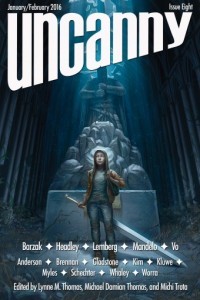 I’m trying to read more short stories again this year, after being semi-retired from the Not If You Were The Last Short Story on Earth project for far too long.
I’m trying to read more short stories again this year, after being semi-retired from the Not If You Were The Last Short Story on Earth project for far too long.
My plan is to find at least 5 stories worth recommending each month, however many I have to read to get to that point! That’s doable, right? As long as we don’t mention January.
“The Heart is Eaten Last” by Kameron Hurley is a Nyx novella, set in the same world as Hurley’s Bel Dame Apocrypha series. It was released this month as a backer reward for Hurley’s Patreon campaign, and I seriously just read it in one afternoon. It was that good. (If you’re not a Patreon backer I don’t know how you can get hold of this but I’m sure someone will publish it, watch this space)
I’m in love with novellas as a format right now, and “The Heart is Eaten Last” is everything I want from a good one – a solid, character-rich story. I hadn’t thought before how much Nyx, in her war-torn city of assassins, magic and beetle technology, is a noir hero before this story, but she totally is – she’s a foul-mouthed Phillip Marlowe hunting the Maltese Falcon, only… she’s not. She’s Nyx, harsh and ruthless and completely fucked up but somehow managing to hold a team together long enough to solve the mystery and save her reputation while hanging on by her fingernails. Meet her terrible judgy sister! Wince at her awful life choices and the mean things she says to people! Cheer at her badassery! Everything I liked about the character and the world in God’s War comes across beautifully here – so much crunchy gender commentary in such a tight, fast-paced adventure. I want want want to read more novellas with Nyx and her team, because I think the format is perfect for Hurley’s cynical, violent prose, and I am far more invested in the characters than I really thought possible.
“The Sincerity Game,” by Brit Mandelo, Uncanny Magazine Issue 8.
A seriously hot story about sex, lies and werewolves, full of raw energy and lovely writing.
“Between the Dragons and their Wrath,” by Rachel Swirsky & An Owomoyela, Clarkesworld Issue 113.
A creepy wonderful exploration of dragons, their people, and the interactions between the two.
“Everybody Loves Charles,” by Bao Shu (translated from the Chinese by Ken Liu), Clarkesworld Issue 112.
Fascinating piece, an exploration of ideas to do with celebrity, privacy and the ownership of identity, through the eyes of two characters: Charles Mann, a successful American author and racing pilot, and Takumi Naoto, one of the millions of subscribers to Charles’ “livecast” who experience his privileged life via implant. There were elements that I stumbled over in this story – particularly the descriptions and characterisations of women which I found stereotyped and uncomfortable (and frankly the two men at the centre of the story were pretty damned unlikeable) – and the over-formal dialogue in many places which I suspect is a product of the author’s original language – but I was still gripped because of the interesting ideas and the length to which they were explored.
“Two’s Company,” by Joe Abercrombie, Tor.com
OMG this story. This is the first piece I’ve ever read by Abercrombie and I am so in love with it I can’t even tell you. Is all his grimdark stuff this funny and gross-out and awesome? Shev and Javre are a wonderful duo of swordswomen that hit all my buttons, reminding me of my love of the old Sword and Sorceress anthologies, and Xena, and Fritz Leiber, and, and, and…
Someone please tell me that these characters have a dozen trilogies to their name already. I am subscribed to the newsletter. I am on the Abercrombie train.
STORY OF THE MONTH:
“The Heart is Eaten Last” by a very narrow margin, because Shev and Javre have won a piece of my soul that I’m just never getting back.
HONORARY REPRINT MENTION:
Issue 8 of Uncanny also features one of my favourite Sarah Rees Brennan short stories from a few years ago, “The Spy Who Never Grew Up,” which is a gorgeous mashup of James Bond and Peter Pan mythology.
February 7, 2016
Sheep Might Fly: Fake Geek Girl Part 3 Show Notes
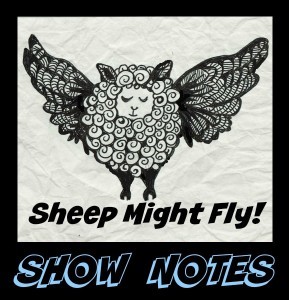 You can listen to the next episode of Sheep Might Fly on iTunes (or your own favourite podcast app, I hope), and also stream, download & follow Sheep Might Fly here on the Podbean site.
You can listen to the next episode of Sheep Might Fly on iTunes (or your own favourite podcast app, I hope), and also stream, download & follow Sheep Might Fly here on the Podbean site.
Our current story is “Fake Geek Girl,” which was originally published in Review of Australian Fiction Volume 14, Issue 4. You can buy the issue containing the story (along with a fantastic piece from Stephanie Lai) directly from their website.
Meet Fake Geek Girl, the band that plays nerdy songs at the university bar every Friday night, to a mixture of magical and non-magical students: lead singer Holly writes songs based on her twin sister Hebe’s love of geek culture though she doesn’t really understand it; drummer Sage is an explosive sorcerous genius obsessing over whether Holly’s about to quit the band to go mainstream; shy Juniper only just worked up the nerve to sing her own song in public and keeps a Jane Austen themed diary chronicling the lives and loves of her friends. When the mysterious, privileged Ferd joins their share house, everything starts to unravel…
In the super short Part 3 of the story, you get the band’s Friday Night set list, annotated by! Holly! Because obviously she’s too busy to narrate a chapter of decent length.
Missed previous episodes? Start from the beginning with Episode 1 or catch up on last week’s Episode 2.
If you like what you hear on Sheep Might Fly, check out Tansy’s blog at tansyrr.com. Talk to Tansy on Twitter (@tansyrr), or check out her other podcasts: Galactic Suburbia and Verity!
You can become a supporter of Tansy & the Sheep Might Fly podcast at Patreon.
February 4, 2016
Friday Links has Fearless Optimism
 L.M. Myles, known to many Australians as Scottish Liz, has a lovely essay up at Uncanny talking about her search for an SFF grandmother, and how the author Naomi Mitchison so beautifully met her very specific requirements.
L.M. Myles, known to many Australians as Scottish Liz, has a lovely essay up at Uncanny talking about her search for an SFF grandmother, and how the author Naomi Mitchison so beautifully met her very specific requirements.
There’s been so much interesting commentary on Star Wars: the Force Awakens this month, and I particularly liked this Mary Sue article by Kate Bennion on the Feminist Message of the Dudes in The Force Awakens, talking about how the kindness and emotional narrative of Finn, Poe and even Han Solo himself make them more likeable and appealing characters to women, while poor old Kylo Ren represents contemporary toxic masculinity at its worst.
In How It Feels To Be Self-Published Me, Zetta Elliot finds her inspiration in a seminal essay by Zora Neale Hurston on coming to terms with being despised for her race, and comes to terms with her own identity as a self published author (as well as a woman of colour) who writes and publishes books for marginalised children.
Chuck Wendig shares some hard but highly entertaining truths about writing and publishing.
I don’t usually get political (ha, except always) on this blog, but I really enjoyed this essay by Joan Walsh about how she learned to be less apologetic about supporting Hillary Clinton.
Liz Bourke talks about the counter in her head (counting women!) over at Sleeps With Monsters.

